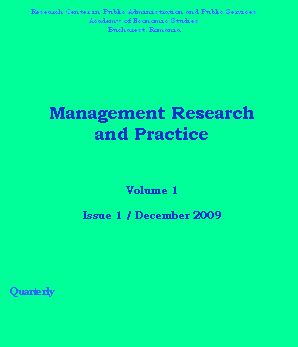
BUSINESS EXCELLENCE AND MANAGEMENT
ISSN
2248-1354 (print)
2668-9219 (online)
ISSN-L: 2248- 1354
|
Home |
|
| Journal description | |
| Aims and scope | |
| Publication ethics | |
| Indexation | |
| Editorial information | |
| Editorial team | |
| Editorial Board | |
|
Journal content |
|
| Current issue | |
| Previous issues | |
| Special issues | |
| Guideline for authors | |
| Submission | |
| Manuscript style | BEMAN Template |
|
|
| Volume 9, Issue 2, June 2019 |
|
1. CAUSE-RELATED MARKETING UNDER THE LENS OF FUNDRAISING METHODS
Andreea-Angela ȘEULEAN
(VONȚEA) Romania DOI:https://doi.org/10.24818/beman/2019.9.2-01 |
|
The nonprofit sector and the organizations that define it are characterized by a particular approach. In this regard, NGOsí overall activity is strongly influenced by their ability of financing it through a generous palette of fundraising methods. The current paper is centered on one of the most used ones, namely the one of cause-related marketing. In this regard, it could be assumed that it acts as a connecting element between the represented social cause and the financial support that could be obtained through financial means from a corporate entity that decides to integrate its own brand image. Moreover, given the fact that it is transaction-based, the fundraising method under discussion requires the presence of a third-party, namely the one of the consumer that decides to support the social cause represented by the nonprofit organization that involves itself in such a mutually beneficial program... |
|
2. CONTEMPORARY DATA SCIENCE FOR FINANCE STUDENTS. ESSENTIAL FEATURES OF COMMONLY USED STATISTICAL SOFTWARE - A COMPARATIVE STUDY
Mădălina Viorica ION
(MANU)
Romania Romania DOI:https://doi.org/10.24818/beman/2019.9.2-02 |
|
This paper inventories some of the essential traits of the software preferred by researchers, students and professors, such as R or RStudio, or Matlab and also their possible utilizations. In order to fill the gap in the Romanian literature and help finance students in choosing proper tools according to the research purpose, this comparative study aims at bringing a fresh, useful perspective in the relevant literature. In Romania, the use of R was the focus of several international conferences on official statistics held in Bucharest, and others having business excellence, innovation and sustainability as purpose. In this time, at global scale, R and Python programming languages are considered the lingua franca of data science, as common statistical software used both in corporations and academia. In this paper, I analyze basic features of such software, with the purpose of application in finance... |
|
3. A LEAN MANAGEMENT APPROACH FOR THE ROMANIAN TEXTILE AND CLOTHING INDUSTRY
Adriana DIMA The Bucharest University of Economic Studies, Bucharest Romania Ruxandra DINULESCU The Bucharest University of Economic Studies, Bucharest Romania DOI:https://doi.org/10.24818/beman/2019.9.2-03 |
|
Lean management represents a systematic approach used for identifying and eliminating waste and non-value added activities from different industries, including the textile industry. Even if the lean manufacturing concept has shown important results in continuous process industry, the textile industry represents a good area for implementing this methodology targeting as a main objective the action of eliminating waste, thus reducing costs and therefore, increasing productivity. Being a customer oriented process, the system has the ability to eliminate a significant part of waste from the Romanian textile industry. As a result, this is an incipient study aimed to present the benefits of implementing Lean Management in the Romanian textile industry, through its improvement tools, as well as presenting a theoretical economic impact for a textile company. Also, taking into consideration that Lean Management is not yet applied in the Romanian textile field, the study will present a part of the areas which would need the Lean implementation, as well as further actions to be taken in order to improve productivity in textile industry... |
Other ASE journals


